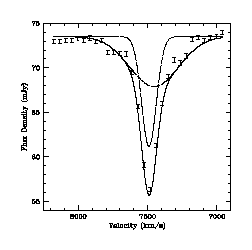
HI Absorption in the Gigamaser Galaxy TXS 2226-184 and the Relation between HI Absorption and Water Emission
G. B. Taylor1, Alison B. Peck2,3, Christian Henkel2, Heino Falcke2, G.C. Mundell4, C.P. O'De5a, S.A. Bau5m, J.F. Gallimore6
1National Radio Astronomy Observatory, P.O. Box 0, Socorro, NM 87801, USA2Max-Planck-Institut für Radioastronomie, Auf den Hüugel 69, D-53121 Bonn, Germany (hfalcke@mpifr-bonn.mpg.de)
3Current address: Harvard Smithsonian Center for Astrophysics, SAO/SMA Project, P.O. Box 824, Hilo, HI 96721, USA
4Astrophysics Research Institute, Liverpool John Moores University, Twelve Quays House, Egerton Wharf, Birkenhead, CH41 1lD, UK
5Space Telescope Science Institute, Baltimore, MD 21218, USA
6Department of Physics, Bucknell University, Lewisburg, PA 17837, USA
The Astrophysical Journal, Vol. 574, p. 88-94
Abstract:
We report on the discovery of HI in absorption toward the gigamaser galaxy TXS 2226-184 using the VLA. The absorption appears to consist of two components -- one with a width of 125 km/s, and one broader (420 km/s), both toward the compact radio source in the nucleus of the galaxy. Based on these large velocity widths we suggest that the HI absorption is produced in the central parsecs of the galaxy, on a similar scale to that which gives rise to the water maser emission. This brings to eight the number of galaxies known to exhibit both water masers and HI absorption. We explore the relationship between these two phenomena, and present a physically motivated (but unfruitful) search for water maser emission in five radio galaxies known to exhibit strong HI absorption.
Paper: Available in PostScript and (AAS)LaTex. Please send an email request to hfalcke@mpifr-bonn.mpg.de for a preprint.
Other publications can be found here.
Questions: Heino Falcke, hfalcke@mpifr-bonn.mpg.de